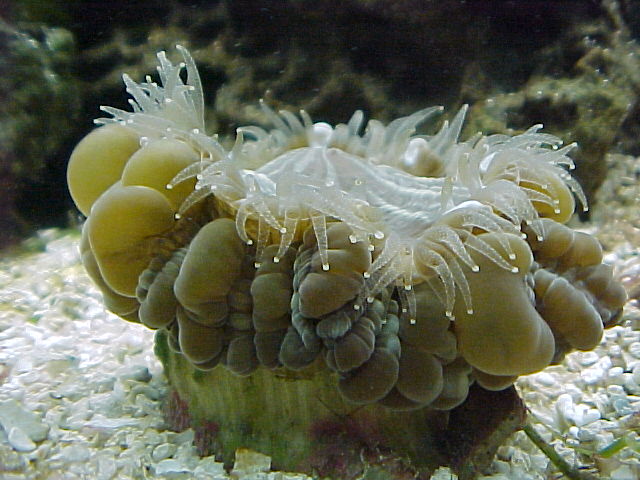Button corals
My first button coral, just after I received it. Notice the large cylindrical stony base, with virtually no inflated polyps.
Here it is from above, more or less fully inflated. Notice the central disc, with bony white plates extending radially from the edge of the central mass.
The fully inflated polyps, looking more like a skirt. They have a shiny green iridescent appearance.
Seen from the side, the skirts are huge, and the coral seems very happy.
A view of the "mouth" from the top. The inner edges of the plates/teeth can be seen in a ring around the mouth. The skirt is fairly well inflated.
A side view of the small translucent feeder tentacles which are extended from the edge of the disk at night. The mouth is in the center foreground, out of focus.
A fully expanded view of the coral, with some turtle weed in the upper left, and a yellow watchman goby hovering above the coral.
An unusual view of this coral, with the skirts mostly deflated, the feeder tentacles out, and the central disk bulging upwards.

Even more unusual, with the feeder tentacles very large, their white tips clearly visible.
A close-up of the central part, with the mouth clearly visible.
Two button corals, hugely inflated, overlapping each other. The one on the left was my original specimen; I purchased the one on the right later on. In the background, just above where the two corals overlap, one can see a rainford's goby in the background. The vertical lines on the left are glare.
The original coral stopped inflating after a while. Here it is towards the end, when it was unable to inflate properly at all. You can see how the [mild] water currents were able to distort the shapes of the polyps.
The skeleton after the coral died: the plates are clearly visible.
A close-up of the "mouth" of the second coral I purchased.
Another close-up of the same coral.
An unusual pose, with the mouth extruded, perhaps to expel waste products.
An unusual pose, with the skirts raised high. Perhaps the coral was trying to settle itself properly in the sand.
A close-up of the mouth when the corals skirts were raised.
Another unusual view, with the mouth extruded and the skirts fully deflated.
A view from on top, fully deflated. The white patch at 6:00 in the picture probably was a "burn" caused by contact with another coral. This spot slowly disappeared over time, but this coral also stopped inflating properly after a few months. It has not yet died, but it is not doing very well.